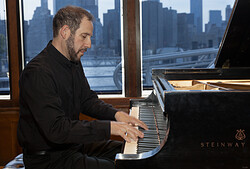In the middle of an aphoristic gallery of portrait pieces by Scott Wheeler on Friday night, the pianist Donald Berman paused, seemingly to look out the window.
At Bargemusic it would miss the point not to. Behind the stage, the most attractive view from any of New York’s concert halls bobs up and down across the East River, the barge undulating as ferries pass. At this time of year, the setting sun reflects off the spire of 1 World Trade Center before the glimmer of skyscraper lights pierces the darkness after intermission.
The view made its mark in Friday’s easygoing, winsome concert, but in Berio, Fauré, Wheeler and especially Ives, the quality and thoughtfulness of Mr. Berman’s playing mattered much more.
His group of Mr. Wheeler’s vignettes and gifts to friends was one of three sets on the program. Most inquisitive was the first, an unusual and illuminating pairing of two short pieces from Berio’s “Six Encores” and two of Fauré’s little-heard Barcarolles. The two composers met harmonically in the middle, Berio looking back in his foggy, light-specked “Luftklavier” (1985) and the reflective, rainy “Wasserklavier” (1965), Fauré pushing remarkably forward in his swishing, luminous Barcarolle No. 1 (1881) and the daring Barcarolle No. 5 (1894). With clear pianism, it proved an effective hop across a century.
Mr. Berman met Mr. Wheeler at the New England Conservatory in 1987, playing in the Dinosaur Annex new-music ensemble. “Hitch your wagon to a good young composer,” the pianist said from the stage, and “one day they might write you a wedding piece.” That piece, the nervously excitable “Epithalamion” (1998), was one of eight endearing miniatures played back to back here. Mostly written in a gently atonal idiom that turned impenetrable only in “Life Study” (2014), they ranged from “Birthday Card for Tony” (1998), a mercurial present for Anthony Tommasini, now chief classical music critic for The New York Times, to a ragtime, cakewalk “Cliff Walk” (2006) and a gorgeous, still song, “Cowley Meditation” (2009).
All that served as a prelude for a spectacular set of Ives. An editor of the composer’s pieces, Mr. Berman has an innate feel for all of Ives’s paradoxes and complexities. He found the perfect balance of fire and rhapsody in the tumultuous “Emerson,” from the Piano Sonata No. 2 (1912), a wonderful spectrum of seriousness — faux, not-so-, and not-at-all — in the crashing, brilliant “Waltz-Rondo” (1911), and a brilliant humor in the collegiate “March No. 5, With Annie Lisle” (1895).
 Back to List
Back to List